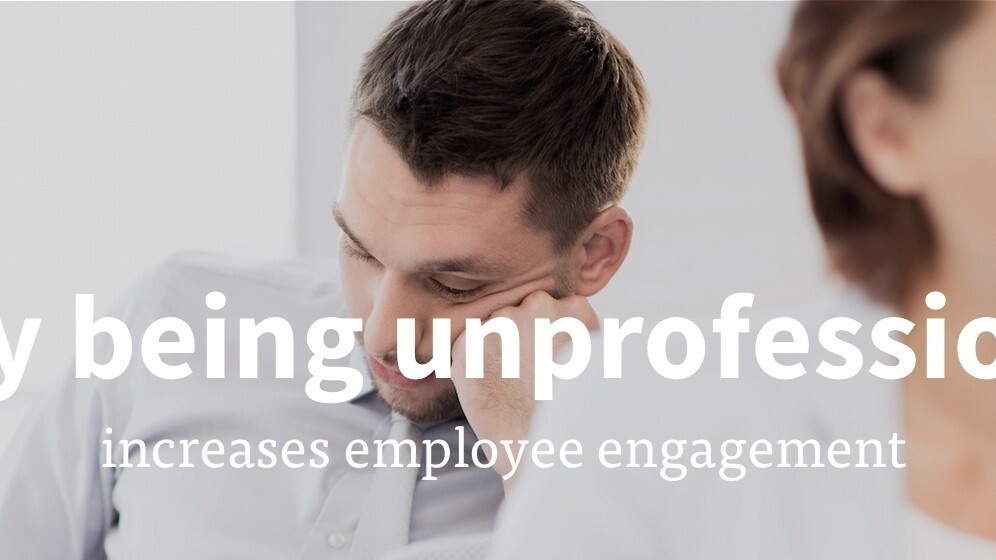
David Hassell is Founder & CEO of 15Five. This post originally appeared on the 15Five Blog.
A recent Forbes article asked the question, “Does Crying Kill Your Career?” This sparks an important conversation about the necessity for an authentic human experience in the workplace. Crying is viewed by many as unprofessional, regardless of gender. However, behaving professionally does not mean that we cease to be human.
Stoicism has little value in the modern workplace as connection and a sense of safety allow employees to perform their best, most creative work. Sometimes emotions get the better of us, and it is far better to release by crying and seek help than to just suppress the feelings and keep pushing through.
Many people become uncomfortable around tears due to fear. Managers are afraid to be sued by handling the situation incorrectly, or even just to cross that imaginary boundary where an employee or a colleague is seen fully as another person. That is one of the reasons why our managers solicit feedback from their teams every week, because the greatest weapon against fear and disconnection in the workplace is asking a question.
Part of asking the right questions is being prepared for the answers you might receive, and the emotions associated with the responses you may not like—but building trust often requires this level of transparency. Some see the expression of emotions as a weakness, while others create safe environments where expressing emotions skillfully can begin a process of breakthroughs.
Disagreements at the workplace inevitably arise and sometimes emotions run high. For example if an employee works on a project for six months and the management team decides not to put it into action, that person can feel marginalized.
It’s not uncommon for anger or tears to well-up as a result. Creating an environment that promotes honesty encourages that person to share their frustration. This ultimately fosters more connection between managers and employees, and can lead to more effective performance.
The skill-set necessary for resolving conflicts with finesse is exemplified in the work of the renowned psychologist Dr. Daniel Goleman. Goleman’s framework of emotional intelligence at work is as important as the intellectual know-how that it takes to get each task done. Crying may be the most authentic response to a very real situation, and this kind of transparency is part of building the trust that is needed to resolve issues and collaborate effectively.
Self-Awareness: Taking A Step Back
At one of our leadership retreats, I had a disagreement with a manager on how to approach an issue. I was advocating for one possibility and he shot down my idea saying, “that’s not it,” but had no alternate solution to offer. We were both livid at first, but our outbursts were followed by a conversation where we discovered one another’s perspectives. I was really attached to my idea and imagined that it was being bulldozed with nothing to replace it.
Taking a step back I realized that wasn’t the reality. When emotions come up, they can get the best of us and cloud our thinking. We get into trouble. We imagine that our reality is the truth, but it is just our perception. We treat our assessments and perspectives as underlying facts. When I cooled off and became more self-aware, I was able to approach the situation with more curiosity for my colleague’s point of view, and feel even more connected with him afterwards.
Empathy: Building A Bridge And Moving On
When multiple realities collide, take a minute to retrace your own thinking and make space for the other person to express their story and point of view, then the crucial conversations can really begin. When the other person feels unsafe to express opinions or dissent, they lock their creativity inside and relationships can be damaged irreparably.
In the Forbes article referenced above, Cheryl Conner offers an example of recommended HR guidelines: “when an employee cries the manager should offer tissues and listen, but should not touch the employee or offer reassurances, as the situation could have liability inferences such as sexual harassment claims.”
I can certainly see the need for guidelines for how managers handle emotional situations at work. But whenever you put rules in place that limit natural behaviors, you are also limiting creativity and authentic human connection. If you want to prevent a car accident from happening, would the solution be to permanently shut down the highway?
Imposing limits to protect against a situation where someone gets emotional and considers suing you may seem like the safest route. But you are putting up a barrier to human interactions that lead to more connection, and higher performance. Shutting down the highway for the one accident that may occur limits all connection and productivity.
The goal is not to avoid these emotional situations. They inevitably happen, and can be accompanied by shame and discomfort because they are not commonly accepted in the workplace. Treating people with humanity and respect creates more understanding, connection, and trust. These can be profound opportunities for personal and interpersonal growth. When handled properly, you are more likely to facilitate long-term loyalty and employee engagement.
Self-Regulation: Making Room For The Range Of Emotions
Emotions are a part of being human, and unexpressed emotions can lead to distress and take their toll on our health. We all want to be healthy humans with a high quality of life, and expressing emotions actually lets the stress out of us. Conversely, shutting off an emotion — or access to it because that’s deemed unprofessional — impacts our overall ability to feel.
To be fully expressed and creative individuals with much to offer, we cannot limit the range of emotions that we are willing to feel. If you want to experience the heights of joy, you have to be willing to experience the depths of pain.
If you want people to experience passion, engagement, inspiration and enthusiasm (great performance) you can’t shut off fear, anger, frustration and pain. If you are looking to build a company of numbed out robots, go for it. But if you want people to operate at their peak, you have to make the opposite acceptable.
Managers have to be cognizant of when employees are overwhelmed by emotion as they may need additional support or some time off. They can also have a negative impact on morale and productivity company-wide. But overall people have to be encouraged to share openly with their managers in the right settings like in their 1-on-1 meetings.
The best-selling book Crucial Conversations, discusses how you can express yourself (no matter how offensively) and feel heard as long as there is safety. Learning to become proficient at creating a sense of safety will allow you to help people express how they really feel.
Issues that would otherwise never see the light of day just fester, but when they are out in the open appropriate action can be taken. This ability to honestly and safely express oneself can also lead to personal breakthroughs. This can manifest in creativity, innovation, and doing great work.
Expectations: Be Careful What You Wish For
When I expect someone to be a jerk, they will probably show up that way in my presence. If I have a permanent story that someone is a jerk, that’s how I will filter every interaction with them. My task is to get to the root of my own story and my own part in creating situations.
Writer and psychologist Gay Hendricks’ believes that each side is 100 percent responsible for the outcome of a situation. Sometimes the difference between resolution and a continual gripe around the water cooler is surrendering to this concept that each side has a part and no one is a victim of circumstance.
Create new possibilities by shifting from labeling someone in your mind with preconceptions and assumptions to taking a completely different road and granting trust to the person.
It’s the difference between this reaction, “he’s being curt and looked frustrated. He doesn’t like me and is just not saying it”, and, “Remember when I mentioned my results on that project? You responded curtly and it seemed that you were frustrated and angry. I made up a story about it and felt like my work doesn’t matter. I may be wrong but I wanted to clear that with you because I want to have a good relationship and do great work.”
Moving through conflict as full-spectrum human beings requires us to look at our own selves with curiosity and come to the table with curiosity for our colleagues. The task then is to mind the gap between where we both are and where we can envision one another to be. This is a courageous task, because looking at the truth can mean that we have to come to terms with the lies that we tell ourselves.
When I look critically at myself, I may see that there is something preventing me from doing my best work. Then I question my perceptions. By questioning my own perspective, I may out my stories as not-quite-truth but something that I made up. Then, I can open up to other perspectives.
From this place, managers and employees or coworkers can come to common ground, working through the conflicts as they arise. We can bring our emotions to the table when there is trust, safety, curiosity and consideration of our colleagues, not as human resources but as human beings. And when we are on the same side of the table, we are united in our mission and can do our best work.
Read Next: Coaching employees in the new economy
Get the TNW newsletter
Get the most important tech news in your inbox each week.









